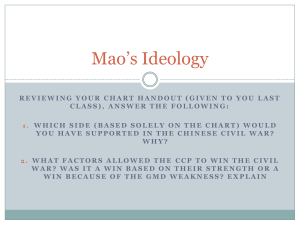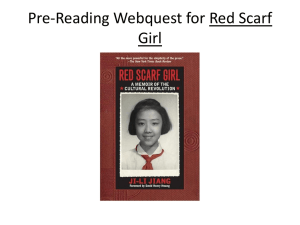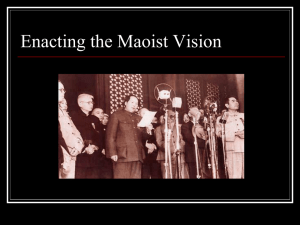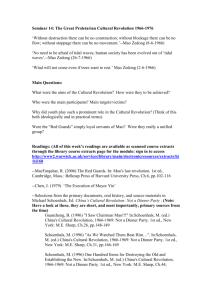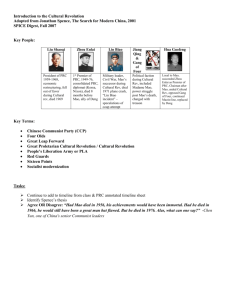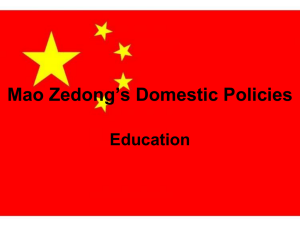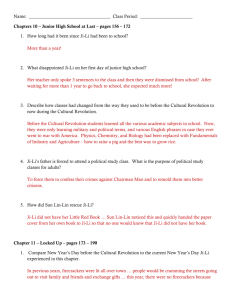Study Guide
advertisement
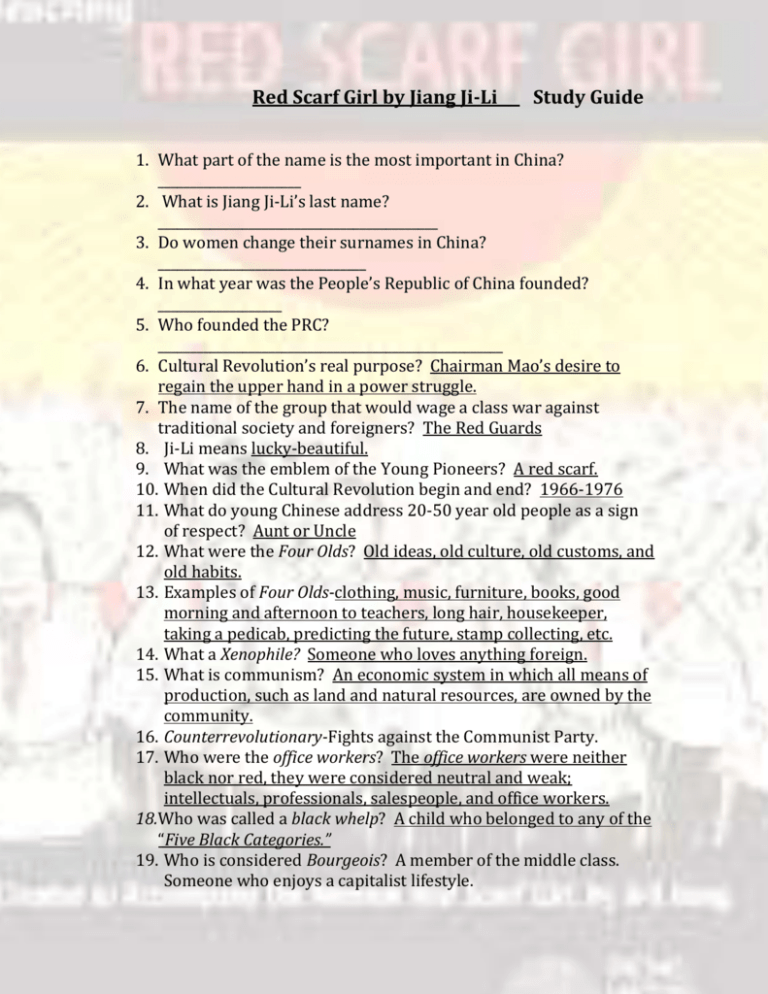
Red Scarf Girl by Jiang Ji-Li Study Guide 1. What part of the name is the most important in China? ______________________ 2. What is Jiang Ji-Li’s last name? ___________________________________________ 3. Do women change their surnames in China? ________________________________ 4. In what year was the People’s Republic of China founded? ___________________ 5. Who founded the PRC? _____________________________________________________ 6. Cultural Revolution’s real purpose? Chairman Mao’s desire to regain the upper hand in a power struggle. 7. The name of the group that would wage a class war against traditional society and foreigners? The Red Guards 8. Ji-Li means lucky-beautiful. 9. What was the emblem of the Young Pioneers? A red scarf. 10. When did the Cultural Revolution begin and end? 1966-1976 11. What do young Chinese address 20-50 year old people as a sign of respect? Aunt or Uncle 12. What were the Four Olds? Old ideas, old culture, old customs, and old habits. 13. Examples of Four Olds-clothing, music, furniture, books, good morning and afternoon to teachers, long hair, housekeeper, taking a pedicab, predicting the future, stamp collecting, etc. 14. What a Xenophile? Someone who loves anything foreign. 15. What is communism? An economic system in which all means of production, such as land and natural resources, are owned by the community. 16. Counterrevolutionary-Fights against the Communist Party. 17. Who were the office workers? The office workers were neither black nor red, they were considered neutral and weak; intellectuals, professionals, salespeople, and office workers. 18.Who was called a black whelp? A child who belonged to any of the “Five Black Categories.” 19. Who is considered Bourgeois? A member of the middle class. Someone who enjoys a capitalist lifestyle. 20. What’s a dazibao? A form of propaganda in the shape of a large handwritten poster used to attack and humiliate people. 21. Who are the masters of the socialist country? The working class. 22. During the Cultural Revolution family relationships were inferior to political principles. TRUE 23. Travelling from province to province was forbidden unless you were a RED GUARD. 24. What was considered the worse class? Landlords 25. What were the 5 Black Categories: Landlords, rich peasants, rightists, criminals, counterrevolutionaries, 26. The sound of drums and gongs meant someone’s home was about to be invaded and ransacked. 27. The writings of Chairman Mao can be found in the Precious Red Book. 28. What were Morning Repentance and Evening Reports? Confessions 29. How was suicide look upon? Suicide was looked upon as a great weakness. Family members were not allowed to mourn or honor this person. 30. In the past women would do what do their feet to make them more appealing? Bind them. 31. Two torn shoes placed around the neck symbolized immorality. 32. The wheel of fate makes a full turn every sixty years means “What goes around comes around.” 33. A tall dunce cap with red X’s was the sign for a criminal. 34. The sweat of honest work was done in the countryside. 35. A hairdo where one half of the head was shaven was known as a yin-yang hairdo. 36. Why didn’t the author hate Chairman Mao? She believed that they were all brainwashed. Many people believed that they were personally wronged but that mistakes happen under any system. If these personal persecutions bettered the country than it was for the best. 37. When did most people wake up to what really happened during the Cultural Revolution? After Mao died in 1976. Notes on Mao Zedong and the Cultural Revolution During the early 1960s, Mao continued his restless challenge of what he perceived as new forms of domination (in his words, "revisionism," or "capitalist restoration"). In foreign policy he led China's divorce from the Soviet Union. Domestically, he became increasingly wary of his subordinates' approach to development, fearing that it was fostering deep social and political inequalities. When Liu, Deng, and others seemed to be ignoring his call to "never forget class struggle," Mao in 1966 initiated the "Great Proletarian Cultural Revolution," exploiting discontent among some students (the "Red Guards") and others. The Cultural Revolution was successful in removing many who opposed his policies but led to serious disorder, forcing Mao to call in the military to restore order in 1967. In 1969 Mao designated Defense Minister Lin Biao, a Cultural Revolution ally, as his heir apparent. But Mao came to have doubts about Lin and soon challenged him politically. One of the issues of debate was the opening to the United States, advocated by Mao and Zhou Enlai as a counter to the Soviet Union. In 1971 Lin was killed in a plane crash while fleeing China after an alleged assassination attempt on Mao. Until his death, a failing Mao refereed a struggle between those who benefited from the Cultural Revolution and defended its policies, and rehabilitated veterans who believed that the Cultural Revolution had done China serious harm. It seemed for a while that the veterans, led by Deng Xiaoping, had won the day. But the radicals, either by manipulating Mao or by appealing to his basic instincts, regained momentum after Zhou Enlai's death in January 1976. Mao chose the more centrist Hua Guofeng to carry on his vision. Four weeks after Mao's death, Hua led the arrest of major radical figures, four of whom — Zhang Chunqiao, Jiang Qing, Wang Hongwen, and Yao Wenyuan — were dubbed a "gang." The post-Mao era has seen a reversal of much that Mao stood for and the eclipse of many individuals, living and dead, that he stood behind. His leadership, especially the Cultural Revolution initiative, has been hotly debated. In June 1981 the Party Central Committee approved a resolution that criticized Mao's rule after 1958, but affirmed his place as a great leader and ideologist of the Chinese Communist revolution. http://afe.easia.columbia.edu/special/china_1900_mao_early.htm



